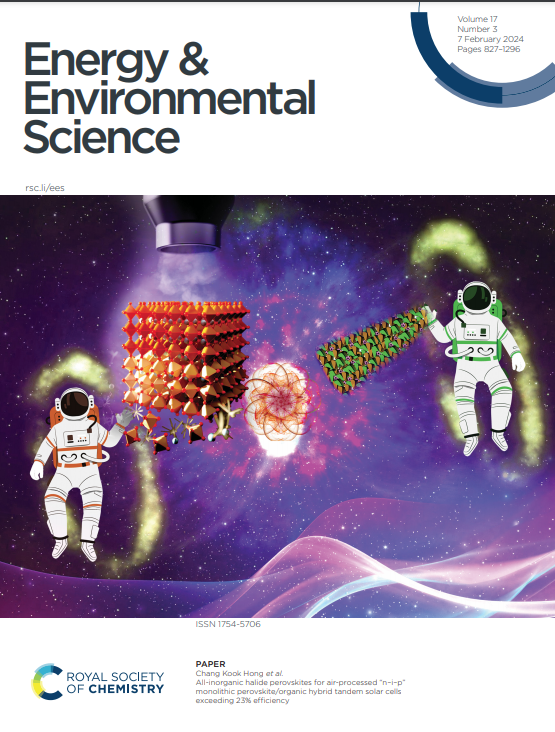在最高占位分子轨道偏移较小的情况下抑制非辐射损耗和高效空穴传输,实现效率高达 19.73% 的二元有机太阳能电池,且效率-成本差距较小
IF 32.4
1区 材料科学
Q1 CHEMISTRY, MULTIDISCIPLINARY
引用次数: 0
摘要
抑制能量/电压损耗并在供体和受体之间的小前沿分子轨道设置上实现高效电荷转移,对于同时提高有机太阳能电池(OSC)的开路电压(Voc)和短路电流(Jsc),进而提高其功率转换效率(PCE)是可行的。本文设计并合成了两种具有不同共轭外侧链的 A-DA'D-A 型受体 PEH-F 和 TEH-F,以追求高效率、高性价比的有机太阳能电池,并将其产业化。与外侧链为噻吩基的 TEH-F 相比,外侧链为苯基的 PEH-F 具有上移的前沿能级、更宽的光带隙和更高的吸收系数。通过采用低成本聚合物 PTQ11 作为供体,基于 PEH-F 的器件实现了 0.511 eV 的低能量损耗,非辐射损耗仅为 0.182 eV,即使在 0.06 eV 的极小最高占据分子轨道偏移下也能实现高效的激子解离和空穴传输。最终,基于 PTQ11:PEH-F 的二元器件实现了 19.73 % 的优异 PCE,同时具有较高的 Voc 和 Jsc,这是迄今为止基于低成本聚合物供体的 OSCs 的最高 PCE。更重要的是,该器件在工业化方面的效率-成本差距较小,估计最低可持续价格(MSP)为 0.35 美元 Wp-1,大大低于其他已报道的高性能 OSC。本文章由计算机程序翻译,如有差异,请以英文原文为准。
Suppressed Non-Radiative Loss and Efficient Hole Transfer at Small Highest Occupied Molecular Orbital Offset Enables 19.73% Efficiency Binary Organic Solar Cells with Small Efficiency-Cost Gap
Suppressing energy/voltage loss and realizing efficient charge transfer at small frontier molecular orbital offsets between donor and acceptor is viable to simultaneously improve open-circuit voltage (Voc) and short-circuit current (Jsc), and thus power conversion efficiency (PCE) of organic solar cells (OSCs). Here, two A-DA’D-A type acceptors, PEH-F and TEH-F, are designed and synthesized with different conjugated outer side chains, to pursue high-efficiency and cost-effective OSCs for industrialization. In comparison with TEH-F (thienyl outer side chain), PEH-F with phenyl outer side chains delivers up-shifted frontier energy levels, wider optical bandgap, and higher absorption coefficient. By adopting low-cost polymer PTQ11 as donor, the PEH-F-based device realizes low energy loss of 0.511 eV with suppressed non-radiative loss of only 0.182 eV, and exhibits efficient exciton dissociation and hole transfer even at an extremely small highest occupied molecular orbital offset of 0.06 eV. Eventually, the PTQ11:PEH-F-based binary device demonstrates a superior PCE of 19.73 % with high Voc and Jsc simultaneously, which is the highest PCE to date for OSCs based on low-cost polymer donors. More importantly, this device shows small efficiency-cost gap for industrialization with the estimated minimum sustainable price (MSP) of 0.35 $ Wp-1, which is dramatically lower than other reported high-performance OSCs.
求助全文
通过发布文献求助,成功后即可免费获取论文全文。
去求助
来源期刊

Energy & Environmental Science
化学-工程:化工
CiteScore
50.50
自引率
2.20%
发文量
349
审稿时长
2.2 months
期刊介绍:
Energy & Environmental Science, a peer-reviewed scientific journal, publishes original research and review articles covering interdisciplinary topics in the (bio)chemical and (bio)physical sciences, as well as chemical engineering disciplines. Published monthly by the Royal Society of Chemistry (RSC), a not-for-profit publisher, Energy & Environmental Science is recognized as a leading journal. It boasts an impressive impact factor of 8.500 as of 2009, ranking 8th among 140 journals in the category "Chemistry, Multidisciplinary," second among 71 journals in "Energy & Fuels," second among 128 journals in "Engineering, Chemical," and first among 181 scientific journals in "Environmental Sciences."
Energy & Environmental Science publishes various types of articles, including Research Papers (original scientific work), Review Articles, Perspectives, and Minireviews (feature review-type articles of broad interest), Communications (original scientific work of an urgent nature), Opinions (personal, often speculative viewpoints or hypotheses on current topics), and Analysis Articles (in-depth examination of energy-related issues).
 求助内容:
求助内容: 应助结果提醒方式:
应助结果提醒方式:


